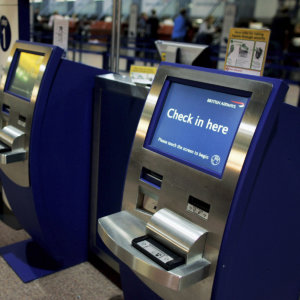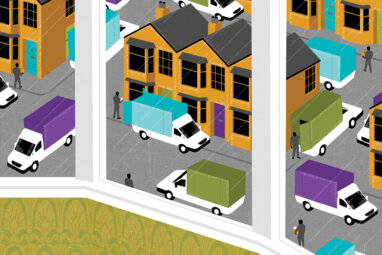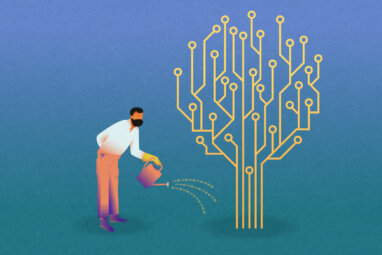How Customers View Self-Service Technologies
There can be substantial differences between managers’ and customers’ perspectives on new self-service technologies.
For many companies, the idea of self-service technology seems like a win-win proposition. Kiosks, websites, mobile apps, and other self-service technologies now let service businesses streamline transaction processes, reduce overhead, and potentially increase revenue — all while giving the customer more control over the service process. In reality, however, there are numerous examples of self-service technologies that have not delivered expected business benefits. For example, the Albertsons LLC grocery store chain, based in Boise, Idaho, decided to remove self-checkout kiosks from its stores in an effort to enhance customers’ overall shopping experience.
Are customers shying away from self-service? No. In fact, customers often prefer self-service to employee-led options. For instance, rental car brands such as Alamo and Enterprise report that self-service kiosks can reduce check-in times by half, leading to greater customer satisfaction with the rental process. Consumers are not running away from self-service options — just poorly implemented ones. Poorly implemented self-service technologies result in frustrated customers or customers who ignore them, as well as unrealized revenue and cost savings for businesses. This raises the question: Do managers really understand what customers want in a self-service offering? From a manager’s perspective, a new self-service medium can create excitement and give tech-savvy customers more options in a desired experience. But managers may not have a good grasp of what customers require in a self-service technology.
To examine whether differences exist between managers’ perceptions of what customers want in a self-service experience and what customers actually want, we surveyed two groups about what they thought customers wanted in a self-service experience: restaurant managers who recently implemented a self-service ordering technology that lets patrons place their own food orders, and customers who used that technology. The survey items for both groups measured concepts such as technology anxiety, need for human interaction, convenience, speed of transaction, perceived accuracy, satisfaction, and trust perceptions.
For the first survey, we sent an invitation to selected subscribers of Nation’s Restaurant News, a popular trade journal. A total of 204 restaurant managers who recently implemented the self-service technology responded. Due to incomplete responses, three surveys were dropped, leaving a total sample of 201. The respondents were fairly evenly split between independent (45%) and chain restaurants (55%). Of the respondents from independent restaurants, about 55% were owners while another 23% were general managers. Of the respondents from chains, 63% worked at the corporate level in chains with over 100 restaurants.
Next, we used a national panel database to survey customers who had previously used this self-service ordering technology. A total of 254 customers responded. The sample was composed of about 51% females, with approximately half of the sample between 35 and 64 years old. Scale items were minimally altered from the managers’ survey to the customers’ survey in order to apply to each group’s perspective in a self-service setting. All scale items were on a seven-point scale from strongly disagree = one to strongly agree = seven.
We analyzed the surveys’ results using structural equation modeling to see if differences between managers and customers were statistically significant. We first examined the influence of technology anxiety on perceptions of convenience and need for human interaction. Next, we explored how convenience and need for interaction influenced the speed of a transaction and perceptions of accuracy. We also examined what constructs had the most influence on evaluations of trust and satisfaction in a self-service experience. We found stark contrasts in three areas: customers’ need for employee interaction, convenience of the self-service technology, and desire for speed in the transaction.
Need for Employee Interaction
Self-service technologies are often implemented with the expectation that customers want to use them and will happily explore them. In reality, however, many customers are hesitant to use a new self-service technology, especially if it departs from the existing script of how the service is supposed to progress. Managers significantly underestimated the need for employee interaction during a self-service experience, especially when customers were exhibiting technology anxiety. Customers want a safety net in case a failure occurs, we found, and they explicitly want an employee to be available. The anxiety that customers can initially feel in using a new technology indicates that self-service is better used along with employees in the early stages of implementation. This may mean little labor savings initially. Once customers’ technology anxiety has subsided, the need for employees may be reduced, thus facilitating labor savings or allowing employees to be redeployed elsewhere.
When a self-service technology is located in a public location, the need for available employees increases. One retailer that does a good job at offering a self-service technology in conjunction with employee support is Bon-Ton department stores. Sales clerks assist customers, but if customers cannot find the desired style or size, they are directed to an “endless aisle” kiosk that lets them browse and order from a wider inventory of products. The self-service technology is an aid not only to the customer but also to the employee.
Convenience
The second area that showed glaring contrasts between managers and customers was the importance each group placed on convenience. A primary reason that customers choose self-service is the belief that it will provide more convenience — which often means the customer chooses how and when the interaction takes place.
Customers noted that the convenience of a self-service technology significantly affected the accuracy of a transaction; managers, on the other hand, rated the influence of convenience as significantly less important to accuracy. Both the virtual and the physical convenience of a self-service technology play a major role in the customer’s comfort and confidence. If customers can choose a convenient time and place to use a smartphone or online app, the experience will be less distracting and more accurate. For example, the online ordering system for Domino’s Pizza Inc., the pizza delivery chain based in Ann Arbor, Michigan, has improved accuracy and increased repeat visits by letting customers place orders at their own pace. Customers can review and verify their orders without feeling pressure to hurry, resulting in greater accuracy.
The physical placement of a self-service technology within a retail outlet affects its convenience, experts say. Self-service technologies located in poorly accessible or low-visibility locations are often ignored by customers because of their perceived inconvenience. Successful self-service technologies will interrupt the flow or line of sight of customers. If the convenience of using a self-service technology is made evident, trial and adoption can happen much more quickly.
Transaction Speed
The third area where managers and customers differed was the importance of speed in the transaction. Speed of transaction had the strongest influence on satisfaction for customers, while managers rated it significantly less important. Many self-service success stories focus on making a utilitarian task faster. For instance, the U.S. Customs and Border Protection agency has installed automated passport kiosks for customs screening at numerous airports. The kiosks have been a success and have reduced wait times significantly. Similarly, the Arizona Department of Transportation Motor Vehicle Division has implemented registration renewal kiosks.
However, managers must educate customers on the appropriate use of the technology. The U.S. Postal Service implemented a kiosk for customers to weigh a package and pay for its postage — but it cannot dispense postage for packages over 70 pounds or for media mail shipping, which customers do not always realize in advance. Similarly, some grocery stores have started posting “15 items or less” signs in their self-service checkout areas so customers know that this service option is for quick transactions. An emphasis on transaction speed also means that store layout, appropriate spacing, and placement are important for avoiding bottlenecks.
In general, the differences between what customers want and what managers think customers want in a self-service experience were enlightening. Managers saw little need for employee assistance, underestimated the importance of convenience, and ultimately undervalued the speed of transaction. These three areas have a tremendous impact on the implementation of a self-service technology and might explain why some self-service applications have received a lukewarm reception. Managers must understand that even tech-savvy customers may initially need employee assistance when using new technologies. After customers become familiar with the technology, the need for employees to be present may be substantially reduced.
As managers try to find new ways to give customers options while focusing on cost-cutting, self-service applications can be an attractive alternative — if you understand what customers want. However, companies that focus more on cost-cutting measures than on customers’ experience may find that self-service technologies produce no more than disenchanted customers and a sunk-cost technology that nobody wants to use.





